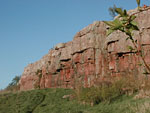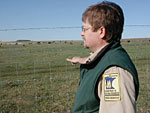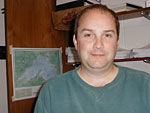By Mark Steil
Minnesota Public Radio
May 23, 2002
If there is one Minnesota state park that breaks the mold, it's probably Blue Mounds near Luverne. While most Minnesota parks are tree-covered, Blue Mounds is mainly open prairie. In a state famous for its natural lakes, Blue Mounds' only lake is manmade. But visitors say those differences are the park's strengths. It's a storehouse of rare plants and animals, touched by a hint of mystery.
| |
|
|
|
||
It's the little things that surprise visitors at Blue Mounds State Park; like dark brown clumps of fur caught in spikes of new grass. It's buffalo wool.
"And that's the remnants of what they had for winter on their backs to keep themselves nice and warm. And by this time of year it's coming off in big clumps," says Dave Rambow, the naturalist at Blue Mounds in southwest Minnesota. He's hiking across green prairie studded with reddish pink boulders looking for the 60 or so bison at the park.
"You never know for sure where they might be, but I think they're over the ridge, just a little to our west, about of a quarter mile away," he says.
The mound is basically a two-mile-wide quartzite rock, a stone harder than granite. It rises several hundred feet above the nearby farm fields. Most of Blue Mounds was never farmed. Rare prairie plants which disappeared under the plow in other parts of the state survived here - like the prickly pear cactus.
"About the end of June these bloom, really beautiful yellow flowers. And they only bloom for about a week out here. But during that week, the whole floor of the prairie here is just yellow with there flowers," says Rambow.
| |
|
|
|
||
Other rare plants at Blue Mounds have exotic names. There are the Dutchmen's Breeches, Western Prairie Fringed Orchid and Prairie Smoke. Jeff Rain of Worthington visits the park often to photograph the wildflowers. It's an intense hunt. Rain says there are so many things to see it may take three hours to cover a few blocks:
"We've been going out there for eight years, and have found things in the last year or two that we have never noticed before. So, it doesn't give up its secrets too easily somedays," Rain says.
Back at the park, the buffalo are found resting in a corner of their fenced pasture. Like two year olds everywhere, this young bison is curious. After a few more sniffs, the animal goes back to grazing.
"They pivot on their front legs. So if they are running, they can change directions as quickly as any pro basketball player," Rambow says.
| |
|
|
|
||
Not far from the buffalo herd, the gentle curve of the Blue Mounds ends in a 50-foot-high cliff almost a mile long. It's believed Indians used the cliffs as a killing tool, driving bison over the sheer drop. Nearby is a mysterious rock formation. It looks like a fallen-down stone fence. Rambow says the rocks are aligned in a perfect east-west line. It's so exact that on the first day of spring and fall, the sun sets exactly in line with the rocks.
"You'll swear as it's setting, it's not going to set in the right spot. Then all of a sudden in the last 30 seconds or so it moves into place and continues on down," he says.
Rambow says one theory is that ancient people laid out the stones to keep track of the seasons. Another is that Indians built a stone barricade to funnel stampeding buffalo over the nearby cliff. Another guess is that the rocks are the remains of a fence built by early farmers. Rambow says he prefers that the rocks remain unexplained, a mystery. Somehow that seems to fit with a landscape that is a bit out of step with the rest of the state.
More Information


